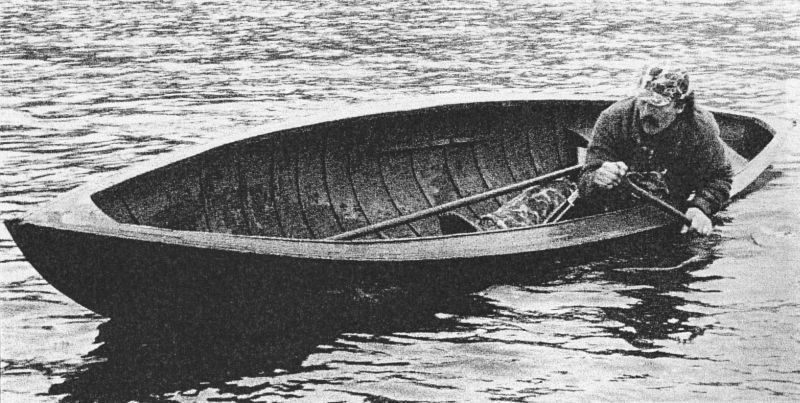|
Susquehanna Chapter |

|
|
The Rollover Duck Boat Originally published in The Canvasback, Fall 1997, Havre de Grace Decoy Museum. Used with their permission. | |

Mike Sanderson, one of the last stalwarts on the Susquehanna River still using a | |
|
The rollover duckboat, unique to the upper Susquehanna River, has been as much a part of local waterfowling history as the men who built and used them. Like the sinkbox and punt boats of the Susquehanna Flats, the rollover has all but disappeared from use. The rollover is a "local" boat, used exclusively by gunners on the Susquehanna River between Sunbury and Highspire, Pennsylvania, and scarcely heard of outside this small stretch of river. The earliest accounts of rollovers come from the 1920's, but it seems like the heyday was up through the 50's and 60's. Interestingly, not at the time when migrating ducks were most plentiful. Gone too, are most of the men who built and used them, except for Ed Myers and Mike Sanderson. Sanderson, of West Fairview, Pennsylvania is one of the last stalwarts still using a rollover to hunt ducks. Ed Myers, from neighboring Enola Pennsylvania, is the only one still alive who built them, and who in fact, built the one Sanderson uses today. The very first rollover was the brainchild of Arlanda Pierce "Apple Pie" Dintaman who was born in 1858. He was a pattern maker at Bethlehem Steel in Steelton, who lived for a time on Hill Island in Middletown, Pennsylvania. He moved his family to the "Hardscrabble" area of Harrisburg which is located along Front Street between Herr and Calder, site of the present day Sunken Gardens, sometime before the turn of the century. Here he opened the Dintaman Boat Livery, along the river at Front and Forster Streets, and rented canoes and dock space to other boaters. The residents of Hardscrabble were forced out of their homes between 1919 and 1923 by legislation sponsored by M. Harvey Exactly when Dintaman built the first rollover still remains a mystery. However, it was from his original patterns that most of the subsequent boats were built. Most were builders from the community of West Fairview, men like Louis "Pappy" Stewart, Charles Glessner, Arby Dissinger and Ed Myers' father Bill, who was assuredly more famous for his career as an all-star shortstop with the Cincinnati Reds. Ed helped his father build over a dozen rollovers but built the last three by himself in 197 1. As the number of ducks declined, so did the demand for new rollovers. Rollovers built on the Dintaman pattern were 15'3" in length, with a few further north in the Sunbury and Millersburg area going to 16 feet. The stem, keel and ribs were made of green oak, which was easily bent to the required shape. The white pine planking was fastened with copper rivets and then the entire hull covered with canvas. The rollover is named for how it is used. The gunner sits to one side of the boat, actually rolling it over on its side. The bottom of the boat pushes up and out of the water, then acts as a floating blind, hiding the shooter from the ducks. The hunter sits in the boat about 200-300 yards off from his decoy spread and waits for the ducks to come into the decoys. A usual spread consisted of three dozen or so black duck decoys and another two or three dozen canvasbacks placed 200 feet downriver. Black duck decoys were favored over mallards because they were easier to paint; canvasbacks draw in every other diving duck. When the ducks settled in between the decoys, the gunner would start his run. The boat was rolled over as far as possible, just so the water didn't come in the side, and the gunner could just barely see over the top. Using a short paddle, an expert could not only sneak right up on the ducks, but actually cut them out of the decoys into open water before shooting. When it came time to shoot, the gunner would "open" the boat, quickly turning the inside of the rollover toward the ducks. Most guys tied a string to their paddle so they could just drop the paddle in the water, saving precious time when reaching for the gun. Occasionally, two men would hunt together in a rollover. The man in the back paddled, while the one up front did all the shooting. Running a rollover was as much of an art as building them. Taking into account strong river currents and high winds during the gunning season, it took an accomplished paddler to use a rollover safely and effectively. Some techniques to running a rollover are shifting your weight forward or backward to fight the wind and paddling faster to make the boat easier to control. Men like Don Oyler and the late Larry Wagner, whom Ed Myers considered the best, made it look easy. It's evident that Mike Sanderson, too, has spent a lot of time in the rollover. I had an opportunity to watch Sanderson in action this past season and came to realize just how effective the rollover is. Mike has been running a rollover ever since he was old enough to hunt on his own, which is evident by the ease with which he runs it. Upriver or down, windy or calm, he deftly maneuvers the boat right into the decoys, opens the boat, and has his gun mounted before the unwary ducks realize their predicament. Traditionally, most of the old gunners, including Dintaman, carved their own decoys for use on the river. Sanderson too, is an accomplished carver who often uses his own birds in his spread. Myers has just recently taken up decoy carving, using various patterns including those of his father. He is also making scale models of his rollovers as well as the other "batty" boats,skiffs and cutdown canoes he used to build. This spring, he intends to build another full-size rollover using the same old Dintaman pattern. With all the new technology of modern boats, calls, decoys, and weapons, coupled with dwindling numbers of migrating ducks, I'm not sure there will be a big demand for new rollovers. But as long as Ed Myers and Mike Sanderson are around. a unique part of our waterfowling heritage is sure to survive. |